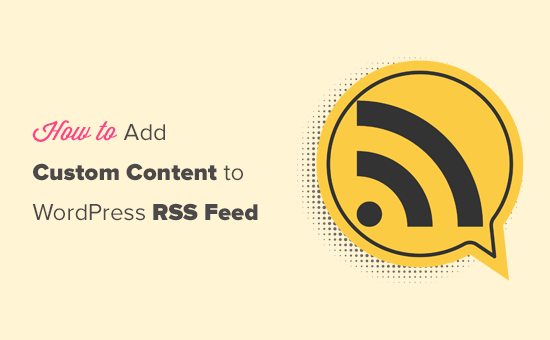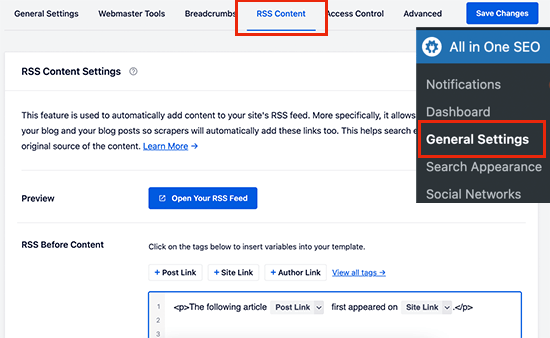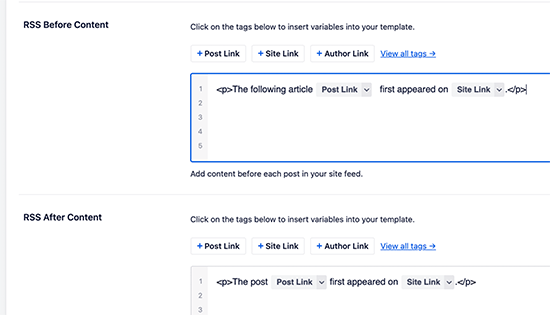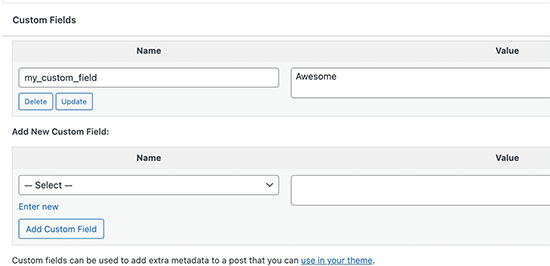Wp Rss Aggregator Feed to Post Custom Field Placeholder
Do you want to add content to your WordPress RSS feeds?
By default, WordPress RSS feeds show your recent post content and there is no option to customize that content for your RSS feed users.
In this article, we'll show you how to easily add content and completely manipulate your WordPress RSS feeds.

Add Custom Content to WordPress RSS Feeds (Easy way)
The easiest way to add custom content to your WordPress RSS feeds is by using the All in One SEO for WordPress plugin. It is the best WordPress SEO plugin on the market and allows you to easily optimize your website SEO.
First thing you need to do is install and activate the All in One SEO for WordPress plugin. For more details, see our step by step guide on how to install a WordPress plugin.
Upon activation, you will be prompted to set up the plugin. Simply follow the on-screen instructions or check out our guide on how to set up All in One SEO for WordPress.
After that, you need to visit All in One SEO » General Settings page and switch to the RSS Content tab.

From here you can add content that you want to display before and after each RSS feed item. You can use smart tags to add links and other metadata to the custom content.

You can also use basic HTML to format your custom content any way you like.
Once you are satisfied with the changes, don't forget to click on the Save Changes button.
All in One SEO will now add your custom content to each RSS feed item.
Adding Content to WordPress RSS Feed using Code
The first method mentioned above is the easiest way to add custom content to your WordPress RSS feeds. However, it adds the content to all items in your WordPress feed.
What if you wanted to add content to specific posts, posts in select categories, or display custom metadata into your RSS feed?
These next few steps will help you flexibly add content to your RSS feed using custom code snippets.
You can add these code snippets to your website using the custom Code Snippets plugin, via functions.php file, or a site-specific WordPress plugin.
Let's try some examples of adding custom content in WordPress RSS feeds manually.
1. Add Data from a Custom Field to Your WordPress RSS Feed
Custom fields allow you to add extra metadata to your WordPress posts and pages. However, this metadata is not included in RSS feeds by default.

Here is a snippet you can use to retrieve and display custom field data in your WordPress RSS feed.
function wpb_rsstutorial_customfield($content) { global $wp_query; $postid = $wp_query->post->ID; $custom_metadata = get_post_meta($postid, 'my_custom_field', true); if(is_feed()) { if($custom_metadata !== '') { // Display custom field data below content $content = $content."<br /><br /><div>".$custom_metadata."</div> "; } else { $content = $content; } } return $content; } add_filter('the_excerpt_rss', 'wpb_rsstutorial_customfield'); add_filter('the_content', 'wpb_rsstutorial_customfield'); This code first checks if the custom field has data inside and the RSS feed is displayed. After that, it simply appends the content global variable and adds custom field data below the content.
2. Adding Additional Text to Post Titles in RSS
Do you want to display additional text to the title of some posts in your RSS feed? Perhaps you want to distinguish between regular articles and guest or sponsored posts.
Here is how you can add custom content to post titles in your RSS feed.
Example 1: Adding Data from Custom Fields to RSS Feed Post Title
First, you would want to save the content you want to display as a custom field. For instance, you can add guest_post or sponsored_post custom fields.
After that, you can add the following code to your website.
function wpb_rsstutorial_addtitle($content) { global $wp_query; $postid = $wp_query->post->ID; $gpost = get_post_meta($postid, 'guest_post', true); $spost = get_post_meta($postid, 'sponsored_post', true); if($gpost !== '') { $content = 'Guest Post: '.$content; } elseif ($spost !== ''){ $content = 'Sponsored Post: '.$content; } else { $content = $content; } return $content; } add_filter('the_title_rss', 'wpb_rsstutorial_addtitle'); This code simply looks for the custom fields. If they are not empty, then it appends the value of the custom field to the post title in your RSS feed.
Example 2: Adding Category Name to Post Title in RSS Feed
For this example, we will display the category name in the post title.
Simply add the following code to your website:
function wpb_rsstutorial_titlecat($content) { $postcat = ""; foreach((get_the_category()) as $cat) { $postcat .= ' ('.$cat->cat_name . ')'; } $content = $content.$postcat; return $content; } add_filter('the_title_rss', 'wpb_rsstutorial_titlecat'); Now, it will show categories along with post titles in the RSS feed. For example, "Top New Restaurants in Bay Area (News) (Travel)" where News and Travel are categories.
3. Add Custom Content to Posts with Specific Tags or Categories
Now let's suppose you want to add custom content but only for posts filed under specific tags or categories.
The following code will help you easily add content to posts filed under specific categories and tags.
function wpb_rsstutorial_taxonomies($content) { if( is_feed() ){ // Check for posts filed under these categories if ( has_term( array( 'travel', 'news' ), 'category' ) ) { $content = $content."<br /><br />For special offers please visit our website"; } } return $content; } add_filter('the_excerpt_rss', 'wpb_rsstutorial_taxonomies'); add_filter('the_content', 'wpb_rsstutorial_taxonomies'); You can modify this code to target tags as well as any custom taxonomies. Here is an example of targeting specific tags:
function wpb_rsstutorial_taxonomies($content) { if( is_feed() ){ // Check for posts filed under these categories if ( has_term( array( 'holidays', 'blackfriday' ), 'post_tag' ) ) { $content = $content."<br /><br />For special offers please visit our website"; } } return $content; } add_filter('the_excerpt_rss', 'wpb_rsstutorial_taxonomies'); add_filter('the_content', 'wpb_rsstutorial_taxonomies'); 4. Add Featured Image to RSS Feed
By default, your WordPress RSS feed does not show featured images for posts. You can change that by manually adding featured images to your RSS feed.
function wpb_rsstutorial_featuredimage($content) { global $post; if(has_post_thumbnail($post->ID)) { $content = '<p>' . get_the_post_thumbnail($post->ID) . '</p>' . get_the_content(); } return $content; } add_filter('the_excerpt_rss', 'wpb_rsstutorial_featuredimage'); add_filter('the_content_feed', 'wpb_rsstutorial_featuredimage'); This code simply checks if a post has a thumbnail (featured image) and displays it along with the rest of your post content
Bonus Resources on Customizing WordPress RSS Feeds
RSS feeds can be a helpful tool in bringing more users and keeping your existing subscribers engaged. Following are a few resources that will help you further optimize your WordPress feeds.
- Best WordPress RSS feed plugins
- How to fix WordPress RSS feed errors
- Tips on optimizing your WordPress RSS feeds
- Exclude specific categories from RSS feeds
- Fetch content from any RSS feed to Your WordPress site (auto-blogging)
We hope this article helped you learn how to add content to your WordPress RSS feeds. You may also want to see our articles on how to add email subscriptions to your WordPress blog and get more free traffic to your website.
If you liked this article, then please subscribe to our YouTube Channel for WordPress video tutorials. You can also find us on Twitter and Facebook.
Disclosure: Our content is reader-supported. This means if you click on some of our links, then we may earn a commission. See how WPBeginner is funded, why it matters, and how you can support us.
Source: https://www.wpbeginner.com/wp-tutorials/how-to-add-content-and-completely-manipulate-your-wordpress-rss-feeds/
0 Response to "Wp Rss Aggregator Feed to Post Custom Field Placeholder"
Postar um comentário